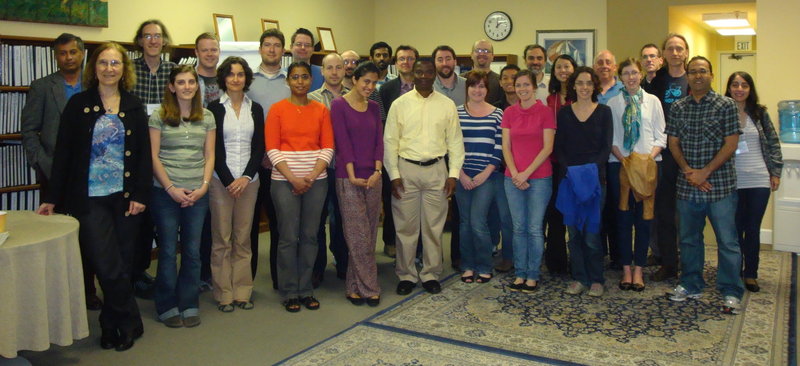Mathematical problems arising from biochemical reaction networks
March 25 to March 29, 2013
at the
American Institute of Mathematics,
San Jose, California
organized by
Alicia Dickenstein,
Jeremy Gunawardena,
and Anne Shiu
Original Announcement
This workshop will be devoted to the mathematical analysis of biochemical reaction networks arising in systems biology. Specifically, we are interested in classes of nonlinear dynamical systems that arise from biologically-relevant networks of chemical reactions, parametrized by rate constants that are usually unknown and difficult to measure. The nonlinearities in these systems have hindered mathematical analysis of network behavior, which has largely been studied by numerical simulation.
Recent developments have suggested that mathematical analysis of such networks may be feasible, using methods from computational algebra, algebraic geometry and dynamical systems. For instance, one class of dynamical systems, coming from mass-action kinetics, gives rise to polynomial dynamical systems. Here, the biologically-relevant steady states are the positive real solutions to a system of polynomial equations and from computational algebra and algebraic geometry have been used to shed light on steady-state behaviour. Difficult questions still remain regarding the transient dynamics and generalisations to non mass-action systems.
The primary aim of this workshop is to bring together mathematicians as well as researchers who are closer to the experimental side of systems biology, in order to formulate precise open problems and to explore appropriate mathematical methods to tackle them. We hope to sustain an open dialogue between theory and experiment, so that they may continue to stimulate each other. Among the problems we may consider initially are the following.
- Decomposition of parameter spaces according to qualitative dynamical behaviour.
- Computation of steady state polynomial invariants.
- The Global Attractor Conjecture.
- Elimination theory and the QSSA (quasi-steady state approximation) approach.
- Extension of mass-action kinetics results to more general kinetics.
Material from the workshop
A list of participants.
The workshop schedule.
A report on the workshop activities.
Papers arising from the workshop:
Numerical algebraic geometry for model selection
by Elizabeth Gross, Brent Davis, Kenneth L. Ho, Daniel J. Bates, and Heather A. Harrington
Lyapunov functions, stationary distributions, and non-equilibrium potential for chemical reaction networks
by David F. Anderson, Gheorghe Craciun, Manoj Gopalkrishnan, and Carsten Wiuf,
Bull. Math. Biol. 77 (2015), no. 9, 1744-1767 MR3423060Parameter-free methods distinguish Wnt pathway models and guide design of experiments
by Adam L. MacLean, Zvi Rosen, Helen M. Byrne, and Heather A. Harrington
ATP concentration c
by Jasmine Nirody and Padmini Rangamani
A global convergence result for processive multisite phosphorylation systems
by by Carsten Conradi and Anne Shiu,
Bull. Math. Biol. 77 (2015), no. 1, 126-155 MR3303108Sign conditions for injectivity of generalized polynomial maps with applications to chemical reaction networks and real algebraic geometry
by by Stefan Muller, Elisenda Feliu, Georg Regensburger, Carsten Conradi, Anne Shiu, and Alicia Dickenstein,
Found. Comput. Math. 16 (2016), no. 1, 69-97 MR3451424Translated chemical reaction networks
by Matthew D. Johnston,
Bull. Math. Biol. 76 (2014), no. 5, 1081-1116 MR3201336Stochastic analysis of biochemical reaction networks with absolute concentration robustness
by David F. Anderson, German Enciso and Matthew Johnston, J. R. Soc. Interface 11: 20130943, 2014 The Author(s) Published by the Royal Society
Rate-independent computation in continuous chemical reaction networks
by H. L. Chen, D. Doty, and D. Soloveichik,
TCS'14-Proceedings of the 2014 Conference on Innovations in Theoretical Computer Science, 313-325, ACM, New York, 2014. MR3359486Deterministic detailed balance in chemical reaction networks is sufficient but not necessary for stochastic detailed balance
by Badal Joshi,
Discrete Contin. Dyn. Syst. Ser. B 20 (2015), no. 4, 1077–1105 MR3315487

